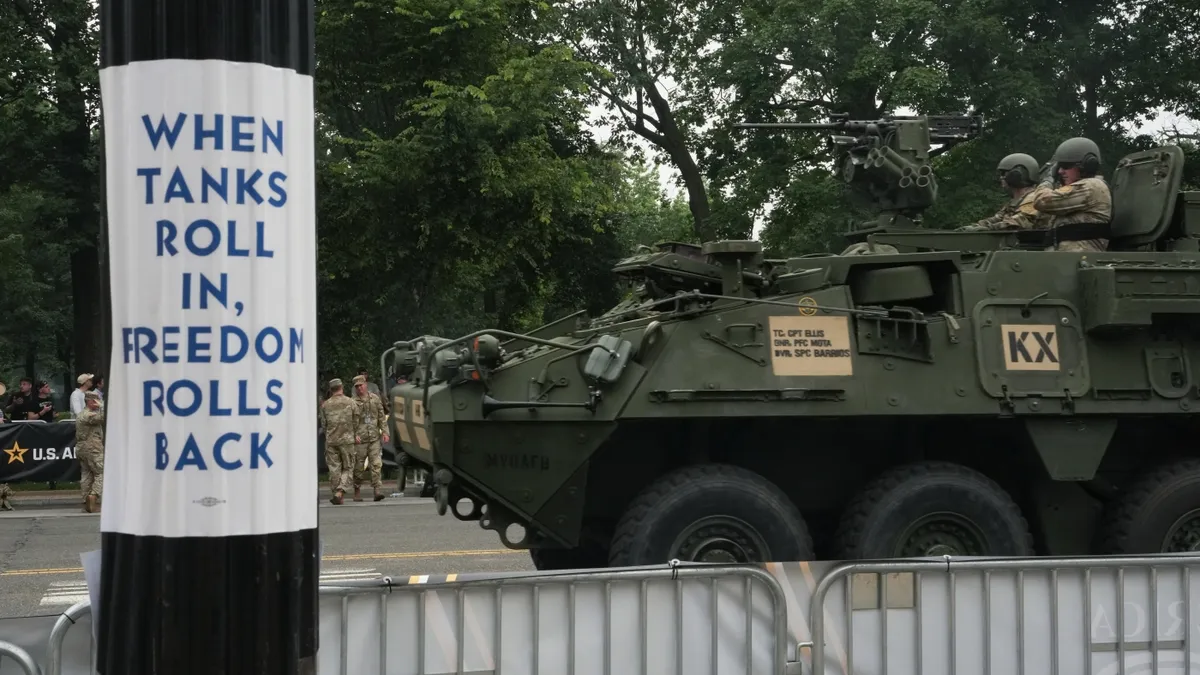
On Saturday, a significant event unfolded in Washington, D.C. and Annapolis, Maryland that highlighted the deep political and cultural divisions in the United States. The military parade commemorating the U.S. Army's 250th anniversary coincided with President Trump's birthday, creating a moment reminiscent of a Rorschach test for America’s societal divides. As the Trump administration prepared for the parade, featuring tanks and armored personnel carriers rolling through the nation's capital, protests erupted in dozens of cities, decrying the event as a politicization of the armed forces by a president perceived as authoritarian.
The protests, branded as No Kings, symbolized a stark contrast to the military spectacle in Washington. The journey from a protest rally in Annapolis to the parade's grandstand in front of the White House felt akin to traveling between two distinct nations. In Annapolis, demonstrators gathered in front of the historic red-brick Maryland State House, displaying signs such as RESISTING THE CROWN SINCE 1776 and I'M A VETERAN, NOT A SUCKER OR A LOSER. This latter slogan referenced comments attributed to Trump that disparaged American war casualties, which he has vehemently denied.
Among the protesters was John Wells, a 76-year-old retired economist, who expressed his disdain for the parade, stating, "It's outrageous. We're not in Russia or North Korea… or China. That's the thing they do." Wells emphasized the significant financial implications of the parade, with costs estimated between $25 million and $45 million.
The protest featured a diverse lineup of speakers, including representatives from labor unions, immigrant advocacy groups, and even a George Washington reenactor. Randy Goldberg, portraying America's first president, delivered Washington's farewell speech from 1783, emphasizing the importance of relinquishing military power. As he concluded, the crowd erupted in applause, reinforcing the protesters' message that Washington willingly gave up military authority, contrasting sharply with their perception of Trump's desire for more power.
Trump dismissed the protests, asserting, "Every other country celebrates their victories. It's about time that America did, too." However, the event was not a victory parade; it was a celebration of the Army's birthday, the first of its kind since the First Gulf War in 1991. Throughout the day, Trump attacked the patriotism of his critics, accusing them of hating the country.
In Annapolis, speakers argued that protesting is a vital form of patriotism, especially against a president they accuse of undermining the checks and balances of American democracy. Donna Edwards, president of the Maryland & DC AFL-CIO, passionately conveyed, "We have to own the flag. No one can tell us that we're not patriots." She emphasized that their presence at the protest demonstrated a commitment to fighting for America.
Meanwhile, the atmosphere at the Army celebration in Washington D.C. was vibrant. Many attendees donned flag-themed apparel, creating a diverse crowd that included military families with immigrant backgrounds from countries like Ecuador, El Salvador, and Vietnam. The event resembled a military festival, with people relaxing on the grass by the Washington Monument and enjoying the sounds of Van Halen blasting from loudspeakers. Tanks rolled past cheering crowds as military personnel engaged with the audience, showcasing a display of strength that resonated with Trump's image of leadership.
Attendees varied in their support for Trump. Some, like Dennis Connelly, a 19-year-old who flew in from Tennessee, defended the president's actions, arguing he operates within legal bounds. Connelly expressed a desire for a powerful president willing to challenge norms, despite acknowledging some concerns about Trump's policies, such as those involving ICE agents and tariffs.
While many parade-goers applauded Trump upon his introduction, numerous NPR interviews revealed that most attendees were primarily there to celebrate the Army and experience the military display. As the parade concluded, several participants began to leave, only to encounter the No Kings protesters. Signs proclaiming Trump is a Tyrant marked the demonstration, revealing the stark divide as attendees exited toward the Metro trains. This moment encapsulated America's polarized landscape, with many individuals unable or unwilling to engage with one another amidst the national celebration.